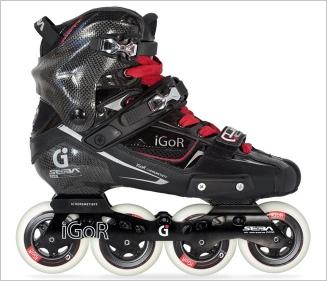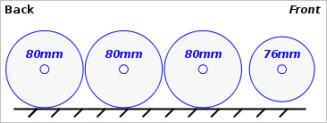This week's tip:
Rocker 'n' Roll
A guide to rockering your inline skates
By Trish Alexander

Seba's Igor Pro with rockered frame
Photo: Seba
Rocker ‘n’ roll.
That’s literally what some skaters do. Before they roll, they “rocker” their skates.
What does that mean?
Simply that they adjust their skates so that some of the wheels — usually the ones in the middle — are closer to the ground.
Why do they do this?
Typically, to increase maneuverability. When the middle wheels are closer to the ground, you can turn more easily because you have less urethane resisting your change of direction.
Think of it like this: If you are lying flat on a wood floor, it is difficult to spin around. This is because you have lots of drag from the various parts of your body — head, torso, limbs.
On the other hand, if you sit on the floor with your feet raised, it’s easy to spin because you only have your bottom touching the floor.
Who should rocker?
It’s not really a question of who should rocker, it’s a question of when to rocker.
If you are a speed skater — and a speed skater only — than you don’t need to rocker. You need as much urethane on the road as possible to get a good push. That said, a good drill for toe-pushers is skating with a small wheel — or no wheel at all — in the front of your skate.
But if you do other kinds of skating — freestyle slalom, hockey, artistic or aggressive — than rockering is for you.
Rockering is helpful whenever your need for maneuverability is greater than your need for speed. It is even helpful for urban and recreational skaters.
So how do you rocker?
You basically have three choices:

Front rocker configuration
Graphic: Mark Kempton (Wikimedia Commons)
1) Front rocker
To “front rocker” your skates, replace your front wheel with one that is a little smaller. So, if you have 80mm skates, put a 76mm wheel in the front slot.
This will give you added maneuverability and stability, making it easier to negotiate curbs and dodge traffic. As a result, it's a popular setup for urban skaters
I wouldn’t advise this setup for brand new skaters. But it’s great for advanced beginners and intermediate skaters. It makes it easier to learn skills like parallel turns and skating backwards.

Full rocker configuration
Graphic: Mark Kempton (Wikimedia Commons)
2) Full rocker
For even more maneuverability, you can fully rocker your skates. To do this, replace both the front and back wheels with ones that are 4mm smaller. So, if you use 76mm wheels, put 72mm wheels on the front and back of your frames.
This configuration makes possible the incredible weaving and turns of freestyle skaters. It’s also the configuration favored by artistic and hockey skaters.
A full rocker setup can feel unstable at first. And that’s not surprising. Much of the time, you’ll only have two wheels on the ground.
So take it slow. And wear your protective gear, including crash pads if you need them.
3) Anti-rocker
Aggressive (street/vert) skater have a different focus: they want to grind. So instead of big wheels in the center of their frames, they want little wheels.
That way they can jump onto their grind plates (between your second and third wheels) without their wheels getting in the way.
This is the anti-rocker configuration … and it comes standard on aggressive skates.
Most of the inline skates produced by the big companies — Rollerblade, K2, etc. — are not rockered. All the wheels are either the same size or, if not, positioned on the frame so that they are all flat with the ground.
It used to be that many skates could easily be rockered by flipping frame bolts or adjusting plastic inserts. But these days that’s usually not an option, so rockering requires installing different sized wheels.
Which, of course, is very easy to do.
That said, a few companies do make rockered skates. Seba sells a freestyle skate with an arched frame (the Igor Pro ... see above).
And several companies make rockered skates for artistic skaters. On the rockered Pic skate, skilled inline skaters can perform one-footed scratch spins — a trick formerly possible only for ice figure skaters.
Be a rocker … at least once.
I feel sorry for skaters who never experience a rockered setup. Rockering heightens your experience of skating. It puts you in touch with the series of arcs and circles that is skating. It also helps you feel your turns and teaches you where to push for maximum power.
And that, dear skater, will rock your rolling world ... no matter what kind of skating you do.
...
 Trish Alexander is the head of the Skate IA and director of the Skate Journey Skate School in Bellevue, WA. She started ice skating as a child and was a competitive figure skater as a pre-teen. She started inline skating in 1994 and began teaching two years later. She is certified to teach Level I, Level II, Master Fitness, Blade Fitness and Fitness Inline Marathon Training. In a former life, she was a paralegal and private detective.
Trish Alexander is the head of the Skate IA and director of the Skate Journey Skate School in Bellevue, WA. She started ice skating as a child and was a competitive figure skater as a pre-teen. She started inline skating in 1994 and began teaching two years later. She is certified to teach Level I, Level II, Master Fitness, Blade Fitness and Fitness Inline Marathon Training. In a former life, she was a paralegal and private detective.